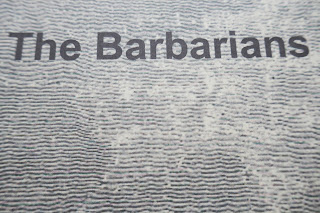"For the love of books" - workshop/talk at Bromley House library - March 2020
Work in progress presented at Bromley House on the 7th March.
"The barbarians" - 2017

 EUROCENTRISM - AFROCENTRISM - EXOTICISM -ECOFEMINISM - RACIAL IDENTITY - RACIAL FLUIDITY - DECOLONISATION - EMPATHY- COMPASSION - RACISM - WHITE PRIVILEGE - WHITE GUILT |
Research - various newspaper and research articles grouped by themes - February-March 2020

Notes copied from sketchbooks-diaries - February-March 2020
Holding opposites within myself.
I am turned into dust. I am not allowed to speak. All my life experiences, all my inner knowledge, grown for years and years, are silenced. I am not allowed to speak.
A woman without a skin.
The scales on our eyes are falling, falling, falling ....
The more you learn, the less you can hide from the truth. the more you learn, the uglier the truth becomes. We are kept alive in the ugliest truth, having to live through it, knowing that we are going to hurt each others and that there is no escape.
There will always be ideas to be thought, critics to be done. Accusations. No perfect work. But a constant ongoing improvement.
Standing in the middle of the fight.
The breaking of the Ego ... We are not the center of the Universe and the Earth does turn around the Sun. We are not the rulers of Nature. And animals are not less important than us.
Fears ... of conflicts, of aggression, of shame, of hurting others, of being horrified, of suffering.
There won't be any reconciliation but deep within myself.
Series of drawings connecting two past dreams - March 2020
In one, from years ago, a blind, mix-race young woman was standing and being swallowed by a gigantic python. She wasn't scared. I was understanding that this had already happened many times : she was being swallowed and spitted out, dying and being reborn again.
In the other dream, more recent, I was on an island with a male companion. We were studying a map and deciding to cross the very large river and leave the island. However, as we were swimming, two albinos pythons (yellow) passed us, swimming opposite way. We thought this was a sign that our idea was not a good one. We came back.
In these drawings, a woman only appears when being swallowed by the serpent. When she is spitted out, her body is covered with scales.
Book presenting a selection of photographs of my city (Nantes, France) taken in 2007.
Ecoprints made on the island of Noirmoutier (France) - Summer 2019.
Wikipedia
(right) This summer I decided to make some more ecoprints from my parents garden. These flowers come from a tree that my mum calls “flamboyant”. She loves this tree and its beautiful flowers. We first saw it on a holiday in Guadeloupe (French Caribbean island). It is quite amazing realise that we can have it grow in France too, despite the climate being much colder !
The Indians, who are not treated well by their Dutch masters, use the seeds [of this plant] to abort their children, so that their children will not become slaves like they are. The black slaves from Guinea and Angola have demanded to be well treated, threatening to refuse to have children. They told me this themselves.
Wikipedia
Ecoprints made with alum salt, iron rust, walnut powder, dried hibiscus flowers, "macabo" leaves (cocoyam / Xanthosoma sagittifoliumSchott), banana flowers - March 2020.
Print of a digitally reworked illustration found in a book from the collection of 19th C travelling books.
Augmented Reality : the printed tree works as a trigger when scanned with a phone using Artivive app. An animation plays on the phone while looking at the prints.
Paper made from the book Onitsha by GMC Le Clézio, with inclusion of found seagulls feathers and fish scales
Island of Noirmoutier (France) - Summer 2019.
Project supported by the Arts Council.
















































Comments